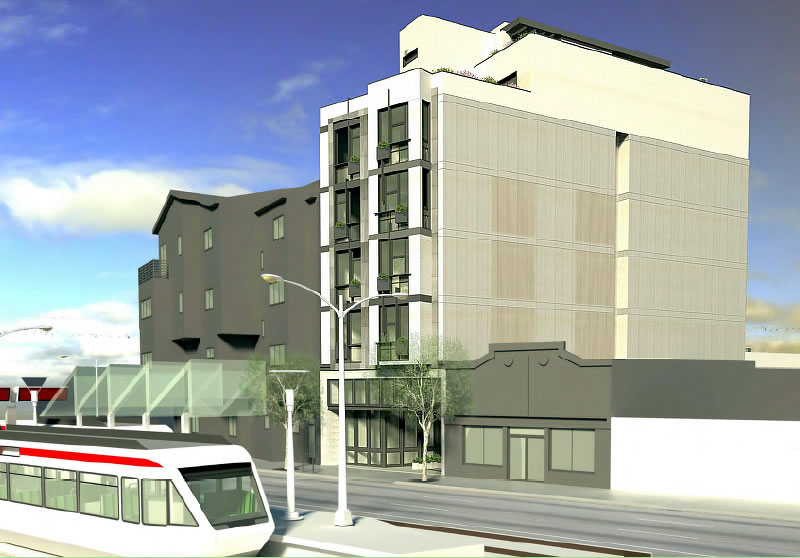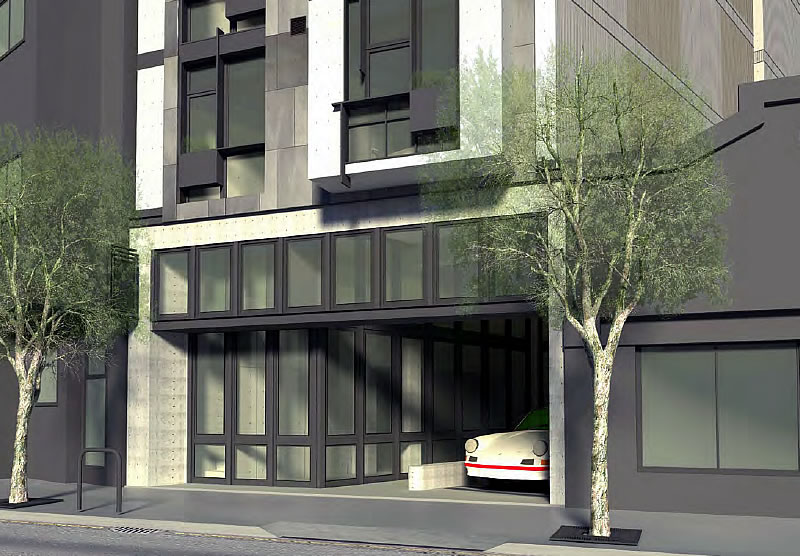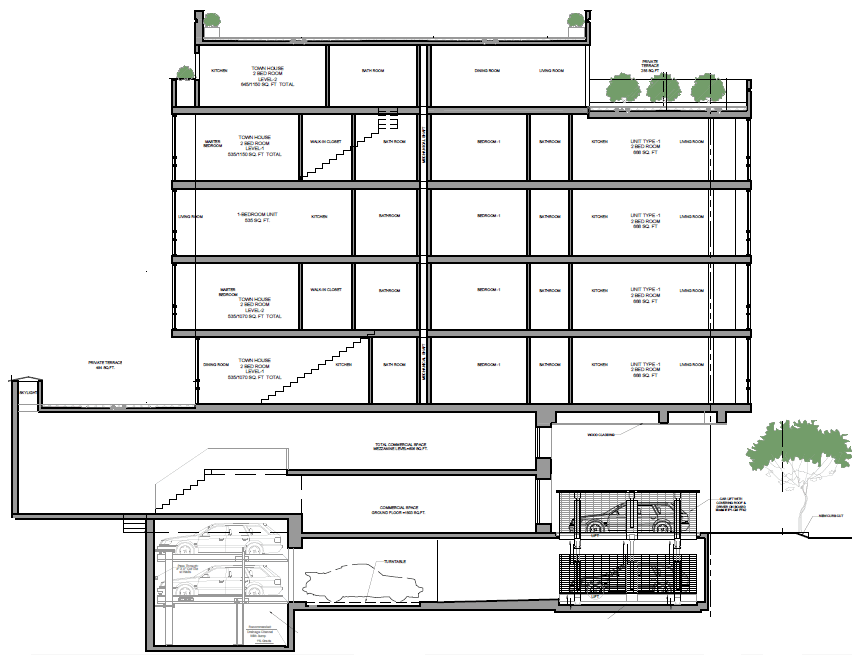Responding to neighborhood concern that fewer off-street parking spaces won’t discourage car ownership but rather increase competition for on-street spaces and congestion, while also addressing concerns that backing cars out of a garage with its entrance on Third Street could impede the efficient movement of bicycles, transit and traffic, not to mention be dangerous, the architects for the proposed seven unit building to rise up to six stories in height upon the skinny Bayview parcel at 4128 Third Street have designed a creative solution.
From Kodorski Design, the architect of record for the development to replace the fire-damaged McAfee’s One Hour Martinizing building on the site:
The proposed development shall be a total of 9,619 [square feet] and will consist of five residential stories above a commercial podium on the ground floor with a basement. It will consist of seven residential units and one commercial space on the ground floor with parking for four cars in the basement.
The structure will be a combination of concrete basement and ground floor with wooden-framed five stories combined with concrete shear walls that extend all the way to the top floor. The building will use modern industrial materials that blend with the surrounding environment creating an aesthetically pleasing and functional structure.
The project will ensure homes for seven families in the industrial triangle and will contribute to the overall growth of the neighborhood and community. The design provides an efficient use of the space within the allowable envelope of the building.
We are providing four car parking spaces in a narrow lot in response to the community demand. This design is a creative response to this challenge which will set a precedent in the Bayview Industrial Triangle for providing an efficient parking solution.
The parking space uses three systems of mechanical equipment; car elevator from the street level to the basement, a turn table in the basement level that reorients the car toward the street to avoid backing out, and finally a double stacker system that ensures a four car parking space in a very efficient way.
And with respect to the development’s commercial space on the ground floor, McAfee Dry Cleaners is slated to return.



Bayview has about the same car to housing unit ratio as Twin Peaks or the Sunset (~1.25), ie sublurbia.
In Miraloma Park near Twin Peaks the car/housing ratio is probably closer to 2.00.
In 5-10 years when Elon Musk’s vision becomes reality, and nobody owns cars any more because robotic taxi rides are cheaper than the bus, then y’all are going to feel silly for demanding all these additional parking spaces that will have become functionally obsolete.
Most of the vehicles in operation in the USA 10 years from now are already in use. The average age of cars and light trucks in operation in the USA is 11.4 years and has been increasing by about one year per decade since the 1960s due to better tech, gov regulations, global competition…
What is silly is anyone that thinks they will have robot taxis to drive them all over SF within ten years. Currently, a Tesla can’t see the broad side of a semi, or at least has trouble distinguishing it from a road sign.
I certainly have not been “demanding all these additional parking spaces.” I just pointed out a fact.
Google Self-Driving cars already operate pretty well on city streets, having driven over 1.5 million miles to date on public roads. That’s today. Imagine what sort of improvements they’ll be able to make over the next five years.
Also today, UberPool is usually less than $10 to go across town, even during rush hour. Imagine how much it would cost if you didn’t have to pay 75% of the fare to a driver.
This will be truly transformative to urban planning, in the same way that diffusion of car ownership was in the 1940’s.
I’m guessing that within 10 years, there will be a multi-hundred million dollar industry in San Francisco alone, just converting old unnecessary parking spaces into studio apartments.
oop, there we go, the new Godwin’s Law, someone thinking that paying $10 to Uber is reasonable and something everyone will want to do and be able to do, therefore why do we need private cars.
It’s very expensive to own a car. Not only gas, maintenance, and depreciation, which can easily exceed $750 a month for a family, but a parking space alone can cost $50K in a big city like SF. And you need two parking spaces: one at the beginning of your trip, and one at the end. That’s $100K societal cost already, before you even purchase the vehicle.
That’s why thousands of people now, already, today, think $10 Uber rides are a very reasonable alternative to vehicle ownership.
It’s already happening now.
But in 5-10 years, if there was no driver to pay, and the price per ride went down 50% or more, then imagine how many more people would prefer to use this method for all of their transportation needs.
The big industry players see it coming, or did you think Uber’s ridiculous valuation comes from nothing?
You are free to disagree of course, if you think this trend will not in fact be transformative, but please provide some sort of argument as to why.
[Editor’s Note: $50K is cheap for a parking space in the city.]
Self-driving cars will become a reality and they will transform transportation in ways we cannot fully forsee at this time. Cheap Uber rides are going to be just the tip of the iceberg. Of course rich people will always have their private cars (self driving or not) and parking spaces to store them in. For everyone else, cars will become a shared commodity based on a subscription service.
Chris Urmson (longtime google self-driving car tech lead) himself recently said it could be 30 years before you get your fully automated taxi service.
I’m all for people being enthusiastic about the potential to use technology to make transport better, but our experience with automating transportation systems is that we have to improve them incrementally and that the improvements need to be systemic and not confined to one element. Smart roadways and car-to-car cooperation will be needed, not just a heroic omniscient robo-pilot.
But don’t worry, I’m sure they’ve already solved 80% of the problem, now they just have to solve the remaining 80%, and then the 80% after that,….
Multi hundred million dollar. What? Are you living in the 60s, dr evil? Thats peanuts
75% to the drive is fairly generous at this point. Uber definitely takes a larger cut if you drive ‘casually’.
What will they do with all that spare storage space….
They’ll probably think of something, but it’ll still be a really awkward layout.
Robot taxis will be cheaper than the bus? Don’t you think they’ll program the robots to demand tips?
Mark my words, pigs will fly in 5-10 years.
What ever happened to the personal flying saucers of the 1960s’ vision of the future?
I’m still waiting on the jet-pack that was due in 2000.
That is a good possibility, but the fact is that the uber wealthy (basically anyone who can afford to buy in SF nowadays) will be hard pressed to get rid of their car even if Uber becomes cheaper than MUNI. Uber still won’t be convenient to get to your vacation house and back.
It doesn’t mean that NEW residents need the same car/housing ratio. Or, more specifically, that new residents of car free housing can’t CHOOSE this housing in a free market. The backflips made to get a few cars into this (and the expense to do so) makes me think that either a) the developer got the lot very cheaply and can afford to gold plate it or b) ain’t never going to happen.
The building is being developed by Mr. McAfee who has owned the site since 1994.
well there you go, then. 🙂
Yes, I believe you are correct that this housing will not require the residents to own or not own automobiles, leaving it to their choice. A common enough condition in SF and even Bayview that we can reasonably (non-caps-lock) forecast the outcome of their many individual choosings over time: about twice as many cars as the planned enclosed parking.
FWIW, about 20% of households in Bayview do not have a car, about the same percentage as live in poverty, per US Census. Similar poverty to no-car statistical correlation holds in the other sublurban hoods of SF. Unless these units are rented to low income households, almost everyone will own at least one car on average over time. This ain’t Nam, curmudgeon, there are rules or at least predictable effects with high probabilities, very high in this case.
People own cars that they park on the street because the city offers street parking at rock-bottom prices. As long as a permit costs $9 a month (if you even need one), people will do that rather than paying tens of thousands to buy private spaces, or using alternative methods of transportation. If this bothers you, work to reform the permit system.
The car emerging from the driveway in the rendering looks suspiciously like a (Porsche) 911: doesn’t seem that they will be targeting either the poor or car haters, if the rendering is meant to be suggestive of reality … though, admittedly, few renderings we see these days suggest reality.
OTOH, that’s not the kind of car one would normally park on the street either.
terrible outcome. Seven units without parking spaces wouldn’t make remotely a noticeable difference in off street parking situation in the neighborhood, considering pretty much every other unit in the neighborhood, which is predominantly single family already has parking and few people actually live in this industrial part of the district. But instead we get a gaping maw of a driveway, instead of continuous pedestrian oriented retail and a tiny, compromised shoehorned retail space that will be hardly successful. Hardly the way to build a successful retail district. Not to mention that now those units will be less affordable because of the exorbitant cost of building underground parking with an expensive turntable, a cost that will have to be born by the future residents and maintained forever. Heaven forbid we provide a diversity of housing stock in the neighborhood, especially right on a light rail line. Sheesh.
As we reported above, the “tiny, compromised shoehorned retail space that will be hardly successful,” will be occupied by the same business which has been on the site since 1996 (and the building is being developed by the business owner).
I don’t think it’s quite that apocalyptic. The T line is great if you’re going north/south but the Bayview has no good east/west transit and the parking is atrocious. Until there’s some convenient transit option to go west, the people who move here are going to bring cars whether we like it or not. Better to get some of them off the street.
couldn’t agree more. any possibility that these apartments could be even remotely affordable to middle class folk is squashed by the private parking, easily adding 10-15% to the rent. not to mention making it harder for the developer to make it pencil, which decreases the likelihood of any new units at al. “neighborhood concern” is code talk for tyranny of the populous.
Seems like an awful lot of engineering for 4 parking spaces.
Agree somewhat, but there was a multi unit building for sale in lower Nob Hill that did not sell for just this reason: no parking. Hey, you can’t expect folks to pony up millions of dollars to buy with no parking amenity. Uber is nice but rich people like options and a car of their very own.
I’m curious– do you have any more info about that multiunit building– address, price? Was it vacant, and was it being sold as a TIC?
As long as the car owners that will be living here pay all of the costs for the design, implementation, construction, and maintenance of said parking engineering complexity.
Ha! Fat chance. It might break even in SOMA, but people aren’t going to be paying underground-stacker prices for parking in the Bayview.
#1- Walk by this business, that awning is pure 3rd world, hand painted looking crap. So how does this cheap ass and unsophisticated business owner have the money for this?
#2- providing all that mechanical, much less the basement dig out is sheer lunacy for 4 parking spots! Especially on a busy street right across from a light rail stop. (This ain’t pac heights.)
Putting #1 and #2 together I smell a case of emboldened-owner-too-big-for-his-britches. And given the precarious phase we are at now in this peak real estate cycle, I smell another family fortune quite potentially going up in smoke. (Just because that vanguard project next door sold for insane prices, perfectly market timed btw, doesn’t mean you’ll get the same 3 years later in a different building.) Yes Bayview is forever changed and moving up. But not that far. And not that fast. Glad I’m just a spectator on this one.
agree totally
Car stackers…that cost a pretty penny.
it appears that this small area has the potential to become a walkable retail strip, so adding a curb cut and driveway where there wasn’t one before seems counterproductive
I agree that the curb cut on Third Street is a real problem for cars and pedestrians along 3rd Street. At least the overall design is interesting and appears to be higher quality than other recently built projects (i.e. the Gary Gee mish-mash next door). Hey, maybe they can arrange to park 4 cars in sub-par retail space next door with access of Innes and create a viable retail space in this nicer looking building.
Now, if they can get rid of that ghetto KFC on the corner and build a nice condo development on that wastefully designed suburbia-ish lot…
They should buy a 20 foot easement from the giant parking lot behind and put the garage entrance there
How is this 4 car parking? Isn’t it only three cars since the fourth one would block the other three? Can anyone explain this?
I think it’s 2 side by side stackers. Each stacker holds 2 cars.
If they really wanted to be innovative, they could have put a patio platform over the car access platform. In the down position, a nice cafe patio. When a car needs to get in or out, just raise the patrons for a few minutes.
I moved a few blocks away from this site about a year ago and my partner and I have one car between us (our place has a garage and we could certainly get another vehicle and park it on the street in front of our house but most people don’t need that many cars, and will probably require fewer in the future as other commenters have mentioned. Neither of us ever drive to work (we bike or take the T).
One of the reasons we moved here was because of the great access to *decent* transit. Forcing the developer to provide parking on this site at the expense of a functional retail space is incomprehensible.